Experimental Study on the Flow Characteristics of Two-Stage Variable Turbines in a Twin-VGT System
Abstract
1. Introduction
2. Establishment of Dual-VGT Two-Stage Variable Turbine Flow Characteristics Test System
2.1. Design of a Dual-VGT Two-Stage Variable Turbine Flow Characteristics Test System
2.2. Calibration of the Cross-Section Position of the Variable Nozzle of the Secondary Turbine
3. Experimental Study on Flow Characteristics of Two VGT Two-Stage Variable Turbines
3.1. Effect of High- and Low-Pressure Stage VGT Blade Opening on the Distribution of Exhaust Available Energy and Expansion Ratio
3.2. Effect of Blade Opening in High- and Low-Pressure VGT on the Turbine Blade Speed Ratio
3.3. Influence of Blade Opening of High-and Low-Pressure VGT on Power Consumption and the Isentropic Efficiency of the Compressor
4. Conclusions
- (1)
- Different degrees of LVGT blade opening have different influences on the available energy of high-pressure stage exhaust gas. With the decrease in LVGT blade opening, the available energy of high-pressure stage exhaust gas increases. Different degrees of LVGT blade opening have different influences on the available energy of high-pressure turbine exhaust. As the blade opening of LVGT decreases, the back pressure of the high-pressure stage turbine increases, the pressure and temperature in front of the high-pressure stage turbine increase and the available exhaust energy increases. The total expansion ratio of two-stage turbines increases with the decrease in blade opening of HVGT and LVGT. When HVGT blade opening is in the range of 60% to 100%, LVGT blade opening has a greater influence on the total expansion ratio, while when HVGT blade opening is in the range of 30% to 60%, HVGT blade opening has a greater influence on the total expansion ratio;
- (2)
- The blade speed ratio of HT is affected by the blade opening of HVGT and LVGT. However, the blade speed ratio of LT is only affected by the blade opening of LVGT. The research results have important guiding significance for the efficiency adjustment of HT and LT under varying altitude and working conditions;
- (3)
- High-pressure-stage compressor power consumption of the high-pressure stage increases with the decrease in the blade opening of HVGT. When the blade opening of HVGT is in the range of 60% to 100%, with the increase in the blade opening of LVGT, the pressure reduction of the high-pressure stage vortex back is small. The power capacity of the high-pressure stage turbine is enhanced and the power consumption of the high-pressure stage compressor is increased significantly. The efficiency of low-pressure stage turbines varies significantly with LVGT blade opening. Compared with an LVGT opening of 100%, when the LVGT opening is 70%, the efficiency of low-pressure stage turbines increases from 10% to more than 50%, which proves that the low-pressure stage turbines are in good alignment. With the increase in HVGT blade opening, the HVGT turbine efficiency increases rapidly when the HVGT opening is between 30% and 60%, while the HVGT supercharger efficiency increases slowly when the HVGT opening is between 60% and 100%.
Author Contributions
Funding
Data Availability Statement
Conflicts of Interest
Nomenclature
| Notations | |
| Isentropic enthalpy drop of the turbine | |
| Exhaust adiabatic index | |
| Cylinder exhaust temperature | |
| R | Gas constant |
| Diameter of the impeller | |
| Speed of the turbine | |
| Ideal speed | |
| Adiabatic index of the intake air. | |
| Intake mass flow rate | |
| Linear speed of the impeller | |
| The total supercharge ratio of the two-stage compressor | |
| The pressurization ratio of the high-pressure compressor | |
| The pressurization ratio of the low-pressure compressor | |
| The total expansion ratio of the two-stage turbine | |
| The expansion ratio of the high-pressure stage turbine | |
| The expansion ratio of the low-pressure stage turbine | |
| The isentropic work consumption of high-pressure compressors | |
| The isentropic work consumption of low-pressure compressors | |
| The maximum turbine efficiency | |
| The efficiency of the low-pressure compressor | |
| The efficiency of the high-pressure compressor | |
| The isentropic efficiency of the high-pressure supercharger | |
| The isentropic efficiency of the low-pressure supercharger | |
| The isentropic enthalpy rise of low-pressure stage compressors | |
| The isentropic enthalpy rise of high-pressure stage compressors | |
| The isentropic enthalpy drop of high stage turbines | |
| The isentropic enthalpy drop of low stage turbines | |
| Ambient temperature | |
| Outlet temperature of the low-pressure compressor | |
| Outlet temperature of the high-pressure compressor | |
| Engine cylinder exhaust temperature | |
| Exit temperature of the high-pressure stage turbine | |
| Exit temperature of the low-pressure stage turbine | |
| Abbreviation | |
| VGT | Variable-geometry Turbocharge |
| ICE | Internal combustion engine |
| Twin-VGT | Twin variable-geometry turbocharging |
| HVGT | High variable-geometry turbocharging |
| LVGT | Low variable-geometry turbocharging |
| HT | High-pressure stage turbine |
| LT | Low-pressure stage turbine |
| HC | High-pressure stage compressor |
| LC | Low-pressure stage compressor |
| BSFC | Brake specific fuel consumption |
References
- Rawat, S.; Patchappalam, K.; Sahare, A. TCV-A unique solution for HD commercial BSIV diesel engine for range of altitude operation. SAE Int. J. Engines 2017, 10, 9–16. [Google Scholar] [CrossRef]
- Liu, R.-L.; Zhang, Z.-J.; Jiao, Y.-F.; Yang, C.-H.; Zhang, W.-J. Study on flight performance of propeller-driven UAV. Int. J. Aerosp. Eng. 2019, 2019, 6282451. [Google Scholar] [CrossRef]
- Ramos, Á.; García-Contreras, R.; Armas, O. Performance, combustion timing and emissions from a light duty vehicle at different altitudes fueled with animal fat biodiesel, GTL and diesel fuels. Appl. Energy 2016, 182, 507–517. [Google Scholar] [CrossRef]
- Szedlmayer, M.; Kweon, C. Effect of Altitude Conditions on Combustion and Performance of a Multi-Cylinder Turbocharged Direct-Injection Diesel Engine. In Proceedings of the SAE 2016 World Congress and Exhibition, Detroit, MI, USA, 12–14 April 2016. [Google Scholar]
- Liu, R.; Lin, C.; Dong, S.; Zhang, Z.; Xu, X.; Zhou, G. High Altitude Calibration Test of Two-stage Adjustable Supercharging System of Diesel Engine. Trans. CSICE 2016, 34, 543–548. [Google Scholar]
- Liu, R. Research on Environmental Adaptability of Diesel Engines at Plateau; Beijing Institute of Technology Press: Beijing, China, 2013. [Google Scholar]
- Wu, G.; Zhang, H.; Wei, M. Numerical Calculation and Analysis of High Altitude Characteristics of Centrifugal Compressor. Veh. Power Technol. 2014, 4, 1–5. [Google Scholar]
- Li, Z.; Zheng, X. Review of design optimization methods for turbomachinery aerodynamics. Prog. Aerosp. Sci. 2017, 93, 1–23. [Google Scholar] [CrossRef]
- Carlucci, A.P.; Ficarella, A.; Laforgia, D.; Renna, A. Supercharging system behavior for high altitude operation of an aircraft 2-stroke Diesel engine. Energy Convers. Manag. 2015, 101, 470–480. [Google Scholar] [CrossRef]
- Wang, Y. Study on Effect of Reynolds Number on Performance of Centrifugal Compressor. Master’s Thesis, Harbin Institute of Technology, Harbin, China, 2012. [Google Scholar]
- Zhao, R.; Zhuge, W.; Zhang, Y.; Yang, M.; Martinez-Botas, R.; Yin, Y. Study of two-stage turbine characteristic and its influence on turbo-compound engine performance. Energy Convers. Manag. 2015, 95, 414–423. [Google Scholar] [CrossRef]
- Zhang, Z.; Liu, R.; Dong, S.; Zhou, G.; Liu, W.; Peng, Q. Thermodynamic cycle characteristics of twin-VGT diesel engine and its control method at variable altitudes. Appl. Therm. Eng. 2022, 211, 118429. [Google Scholar] [CrossRef]
- Yao, Y.; Shi, L.; Zhang, Z.; Xiao, M.; Liu, M.; Tan, J. Research of the High Altitude Control Strategy of the Piston Aero-Engine Using Two-Stage Turbocharger Coupled with Single Supercharging System; SAE Technical Paper; SAE International: Warrendale, PA, USA, 2019. [Google Scholar]
- Liu, R.; Zhang, Z.; Dong, S.; Zhou, G. High-Altitude Matching Characteristic of Regulated Two-Stage Turbocharger with Diesel Engine. J. Eng. Gas Turbines Power Trans. ASME 2017, 139, 094501. [Google Scholar] [CrossRef]
- Kovacs, D.; Eilts, P. Potentials of Miller Cycle on HD Diesel Engines Using a 2-Stage Turbocharging; SAE Technical Paper; SAE International: Warrendale, PA, USA, 2018. [Google Scholar]
- Li, C. Matching and Regulation of Adjustable Two-Stage Supercharging System of Diesel Engine at Plateau. Master’s Thesis, Beijing Institute of Technology, Beijing, China, 2016. [Google Scholar]
- Llamas, X.; Eriksson, L. Control-oriented compressor model with adiabatic efficiency extrapolation. SAE Int. J. Engines 2017, 10, 1903–1916. [Google Scholar] [CrossRef][Green Version]
- Kozak, D.; Mazuro, P. Numerical Analysis of Two-Stage Turbine System for Multicylinder Engine under Pulse Flow Conditions with High Pressure-Ratio Turbine Rotor. Energies 2023, 16, 751. [Google Scholar] [CrossRef]
- Zhang, H.; Tang, X.; Mu, L.; Shi, L.; Deng, K. Theoretical and experimental investigation of the pressure ratio distribution and the regulation strategy of a two-stage turbocharging system for various altitudes operation. J. Mech. Sci. Technol. 2021, 35, 1251–1265. [Google Scholar] [CrossRef]
- JB/T9752.1-2005; Turbochargers Part 1: General Technical Conditions. National Development and Reform Commission (NDRC): Beijing, China, 2005.
- JB/T9752.2-2005; Turbochargers Part 2: Test Methods. National Development and Reform Commission (NDRC): Beijing, China, 2005.
- Kozak, D.; Mazuro, P.; Teodorczyk, A. Numerical simulation of two-stage variable geometry turbine. Energies 2021, 14, 5349. [Google Scholar] [CrossRef]
- Thomasson, A.; Leufvén, O.; Criscuolo, I.; Eriksson, L. Modeling and validation of a boost pressure actuation system, for a series sequentially turbocharged SI engine. Control. Eng. Pract. 2013, 21, 1860–1870. [Google Scholar] [CrossRef]
- Li, H.; Shi, L.; Deng, K. Research on the power recovery of diesel engines with regulated two-stage turbocharging system at different altitudes. Int. J. Rotating Mach. 2014, 2014, 209084. [Google Scholar] [CrossRef]
- Yang, M.; Gu, Y.; Deng, K.; Yang, Z.; Liu, S. Influence of altitude on two-stage turbocharging system in a heavy-duty diesel engine based on analysis of available flow energy. Appl. Therm. Eng. 2018, 129, 12–21. [Google Scholar] [CrossRef]
- Liu, Y. Systematic Optimization and Control Design for Downsized Boosted Engines with Advanced Turbochargers. Master’s Thesis, The Ohio State University, Columbus, OH, USA, 2014. [Google Scholar]
- Han, Z. Study on parameter selection of two-stage supercharging system and its influence on combustion process. Ph.D. Thesis, Tianjin University, Tianjin, China, 2013. [Google Scholar]
- Li, H.; Zhang, G.; Zhang, H.; Shi, L.; Yang, M.; Deng, K. Equivalent matching model of a regulated two-stage turbocharging system for the plateau adaptability. Proc. Inst. Mech. Eng. Part D J. Automob. Eng. 2016, 230, 1654–1669. [Google Scholar] [CrossRef]
- Song, Y.; Xu, Y.; Cheng, X.; Wang, Z.; Zhu, W.; Fan, X. Using a Genetic Algorithm to Achieve Optimal Matching between PMEP and Diameter of Intake and Exhaust Throat of a High-Boost-Ratio Engine. Energies 2022, 15, 1607. [Google Scholar] [CrossRef]
- Rathod, D.; Xu, B.; Filipi, Z.; Hoffman, M. An experimentally validated, energy focused, optimal control strategy for an Organic Rankine Cycle waste heat recovery system. Appl. Energy 2019, 256, 113991. [Google Scholar] [CrossRef]
- Wu, B.; Han, Z.; Yu, X.; Zhang, S.; Nie, X.; Su, W. A method for matching two-stage turbocharger system and its influence on engine performance. J. Eng. Gas Turbines Power 2019, 141, 054502. [Google Scholar] [CrossRef]
- Shi, X.; Wang, T.; Ma, C. Simulations of the diesel engine performance with a two-stage sequential turbocharging system at different altitudes. Proc. Inst. Mech. Eng. Part D J. Automob. Eng. 2014, 228, 1718–1726. [Google Scholar] [CrossRef]
- Liu, B.; Deng, K.Y.; Cui, Y. Equivalent turbocharger model of regulated two-stage turbocharging system. J. Energy Inst. 2010, 83, 195–201. [Google Scholar] [CrossRef]
- Zhu, D.; Sun, Z.; Zheng, X. Turbocharging strategy among variable geometry turbine, two-stage turbine, and asymmetric two-scroll turbine for energy and emission in diesel engines. Proc. Inst. Mech. Eng. Part A J. Power Energy 2020, 234, 900–914. [Google Scholar] [CrossRef]
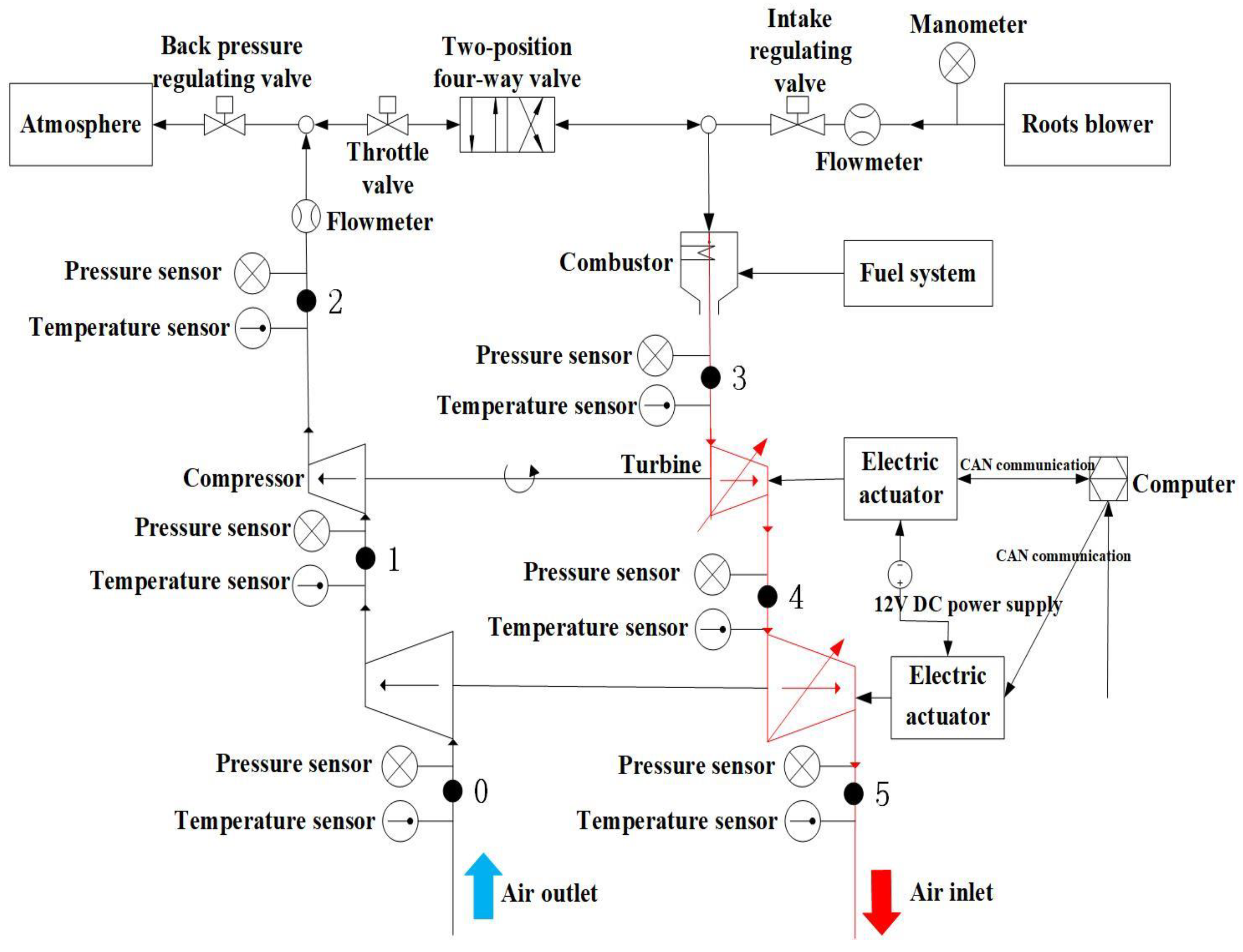
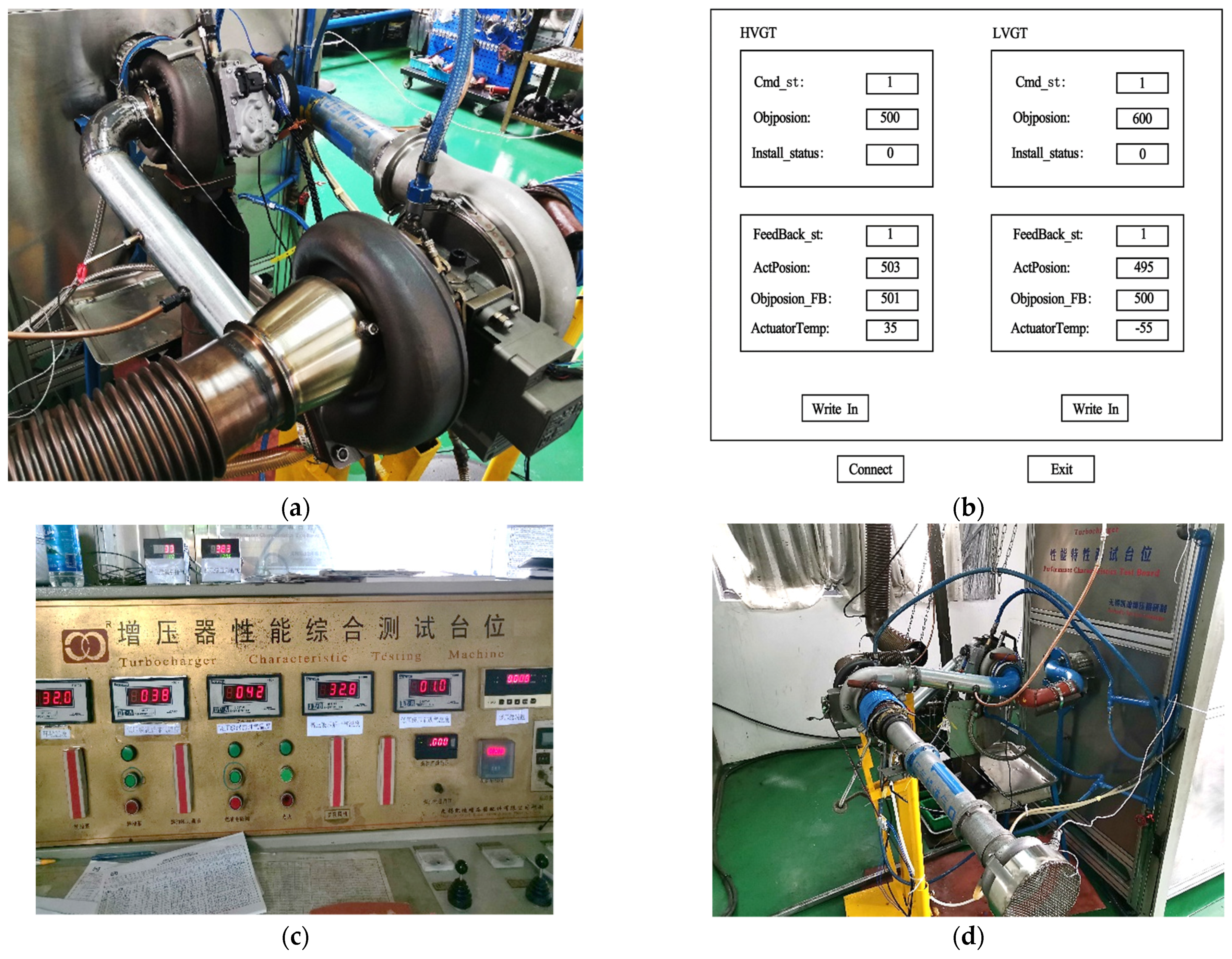
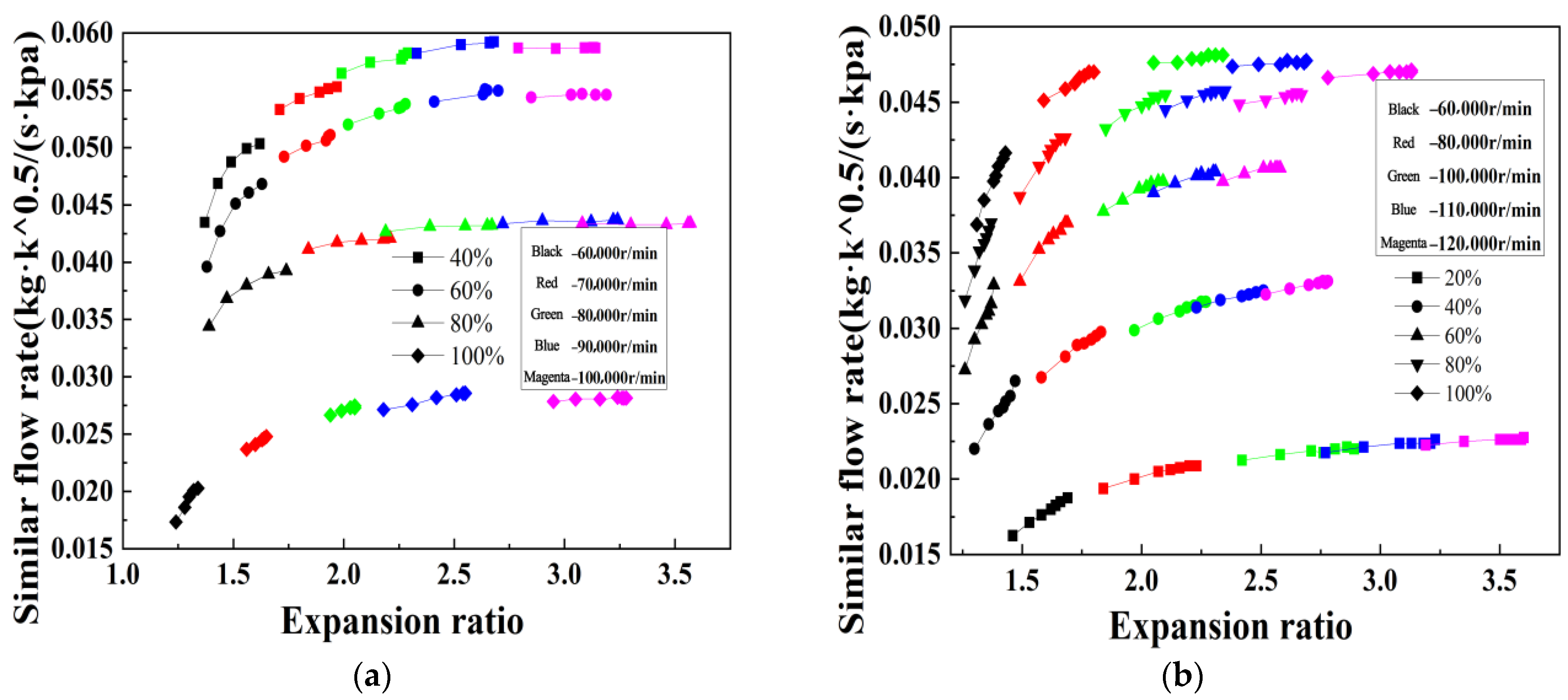
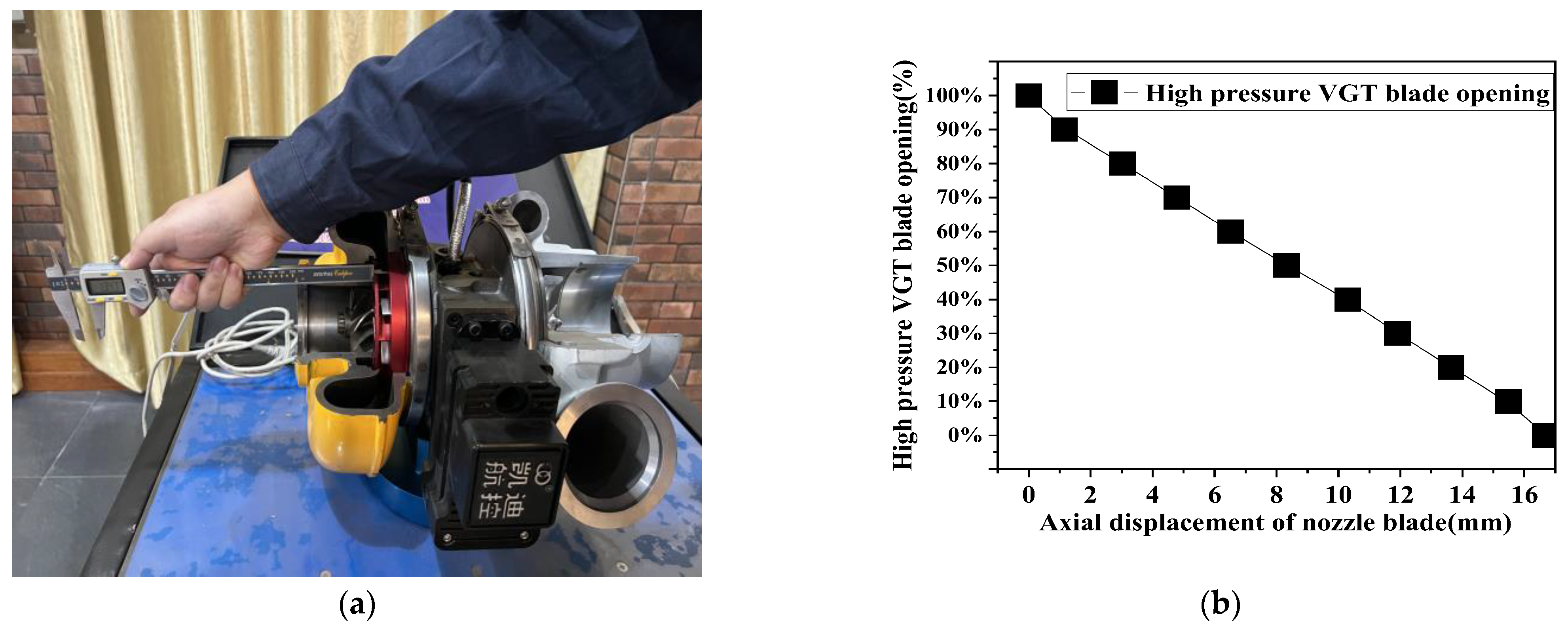
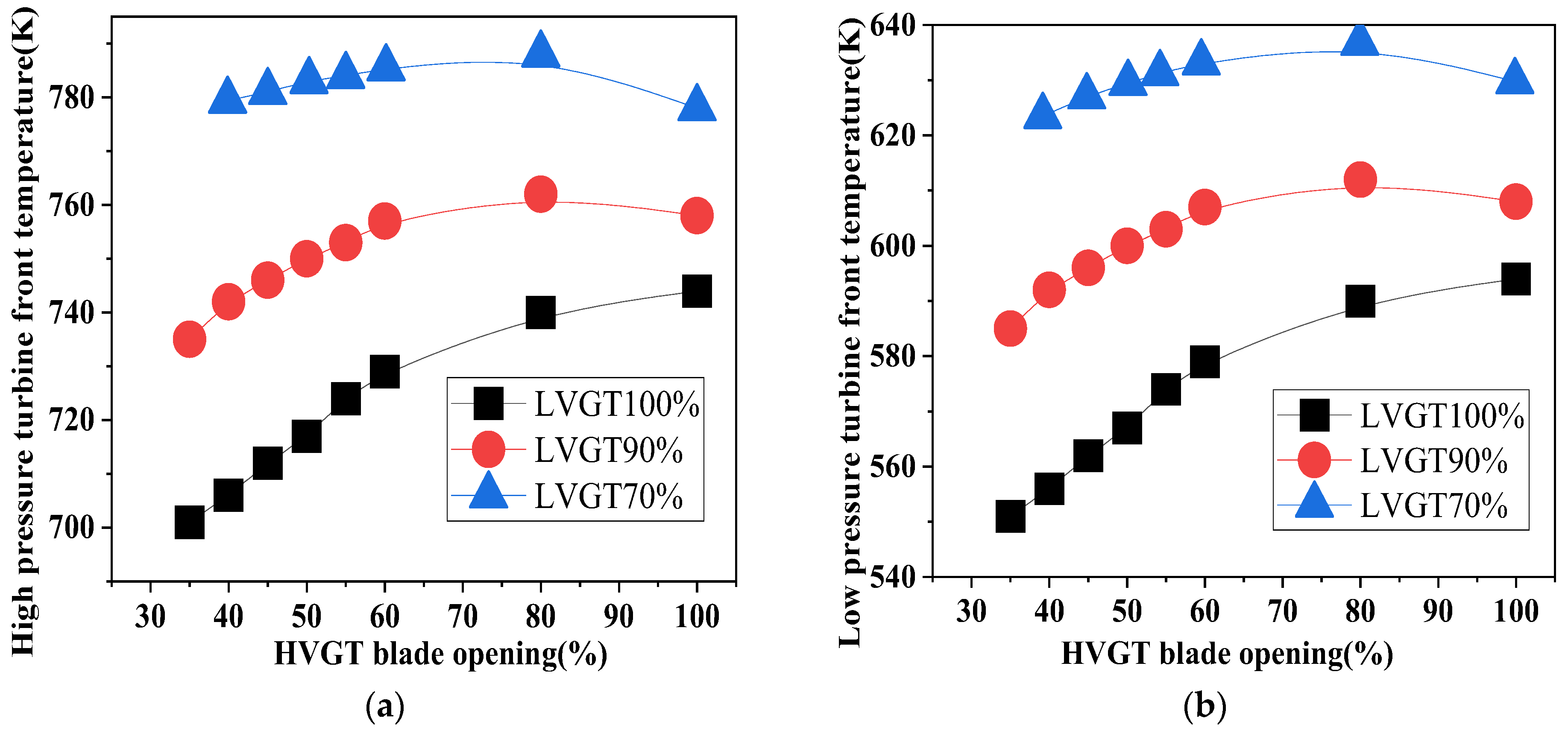
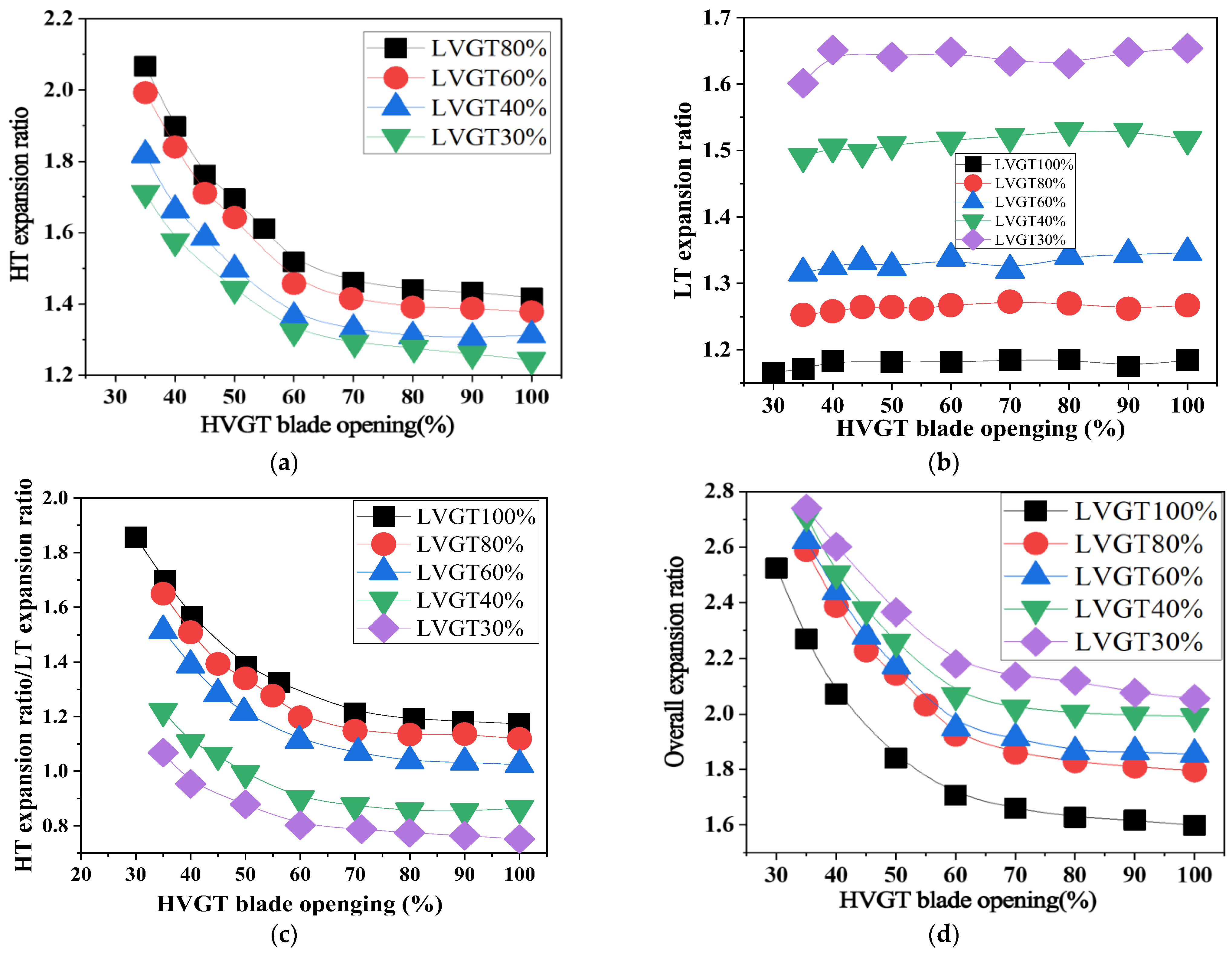

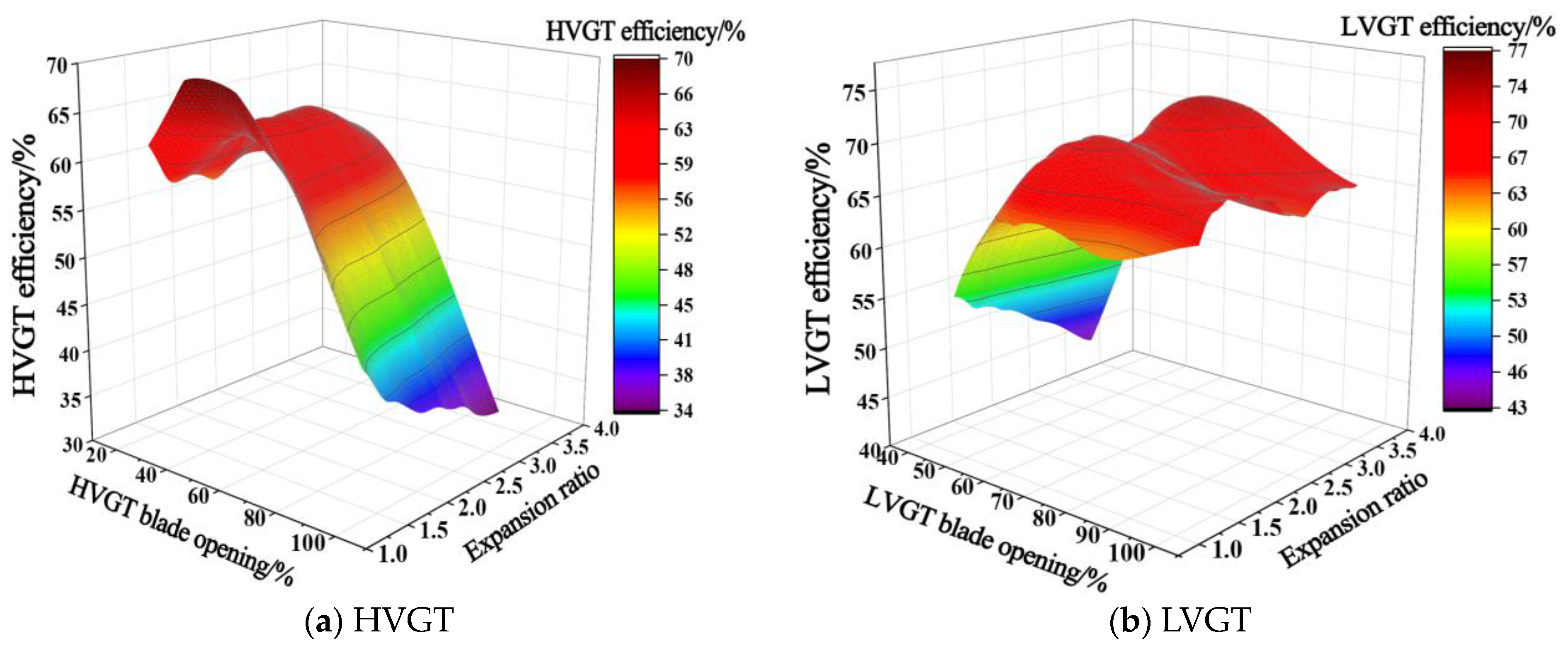
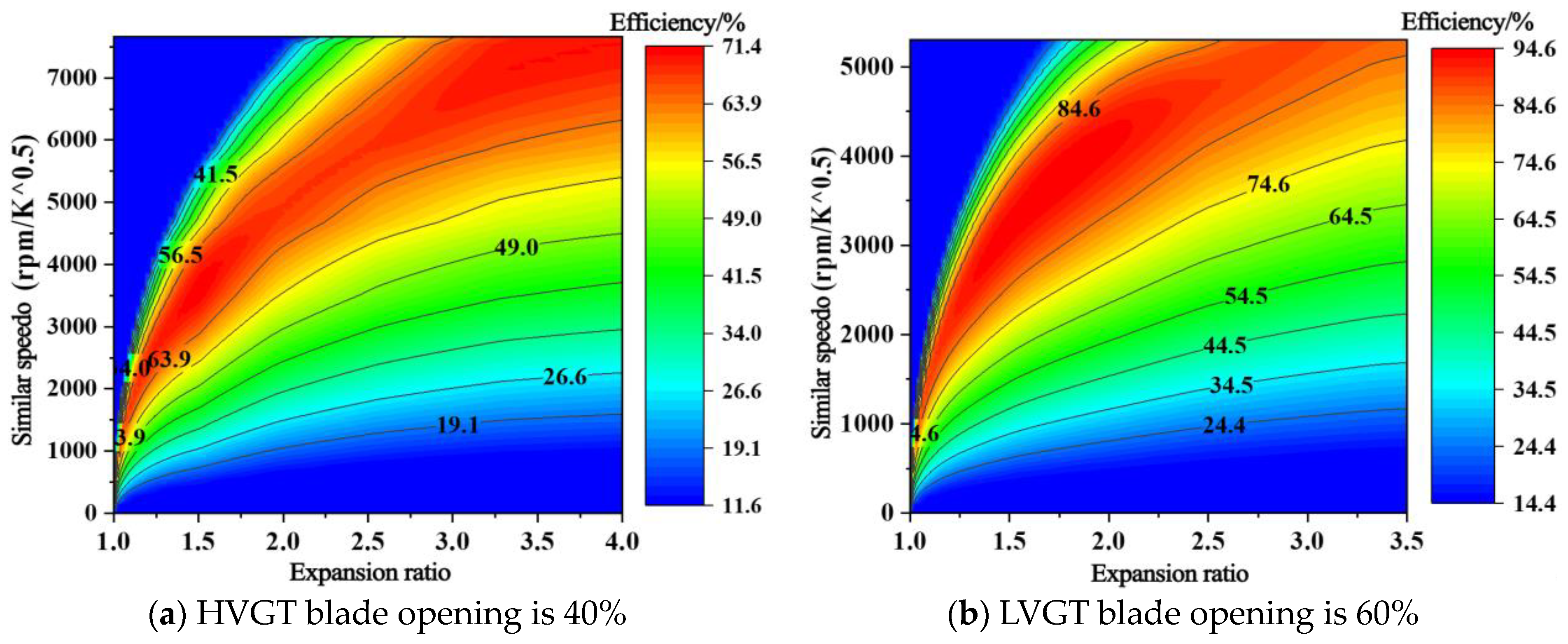
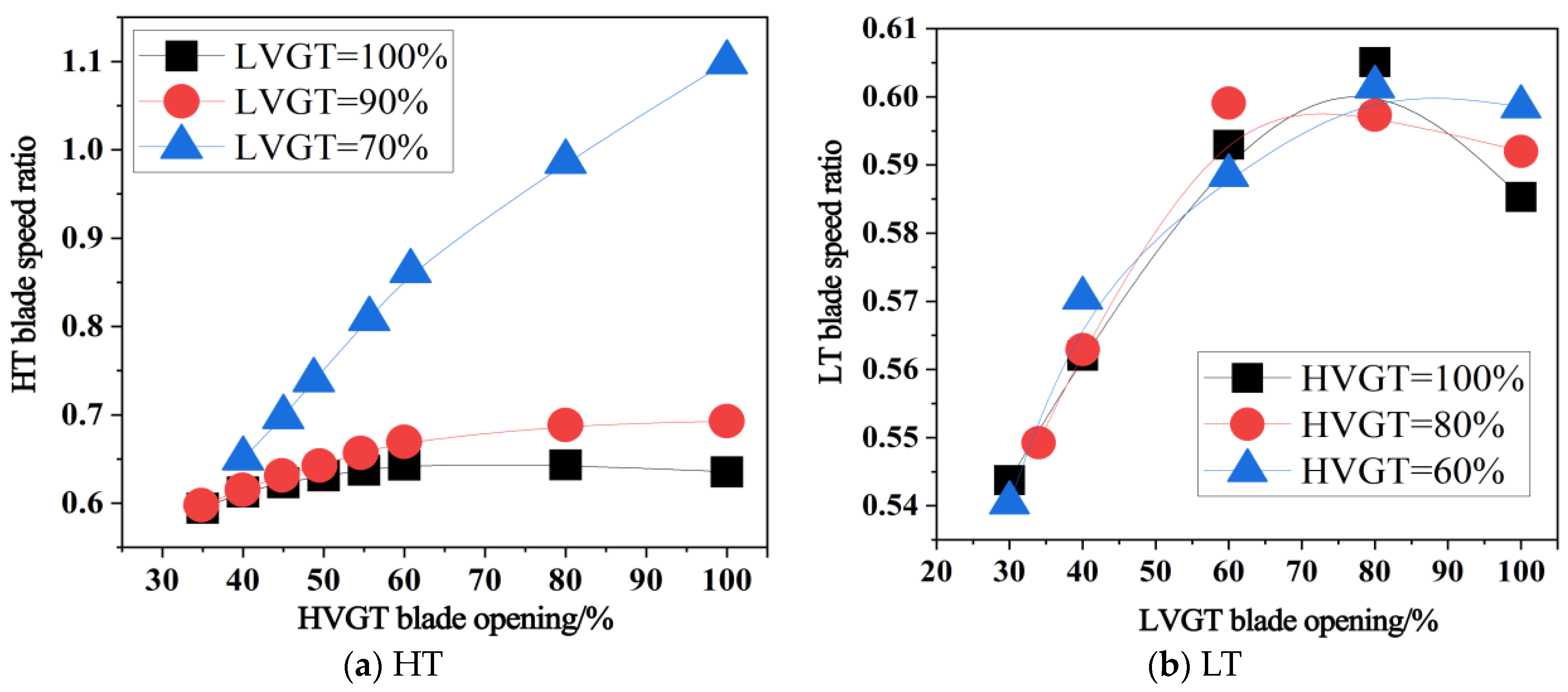

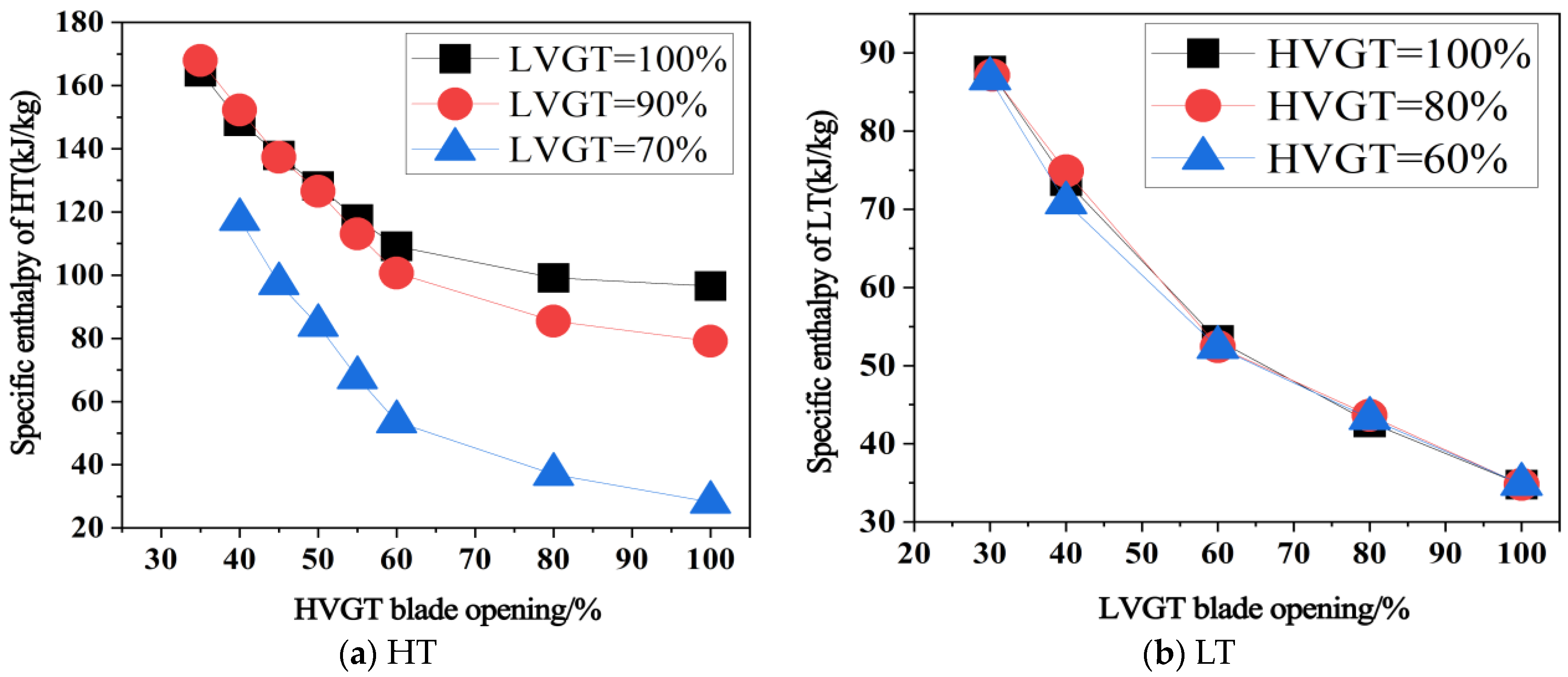
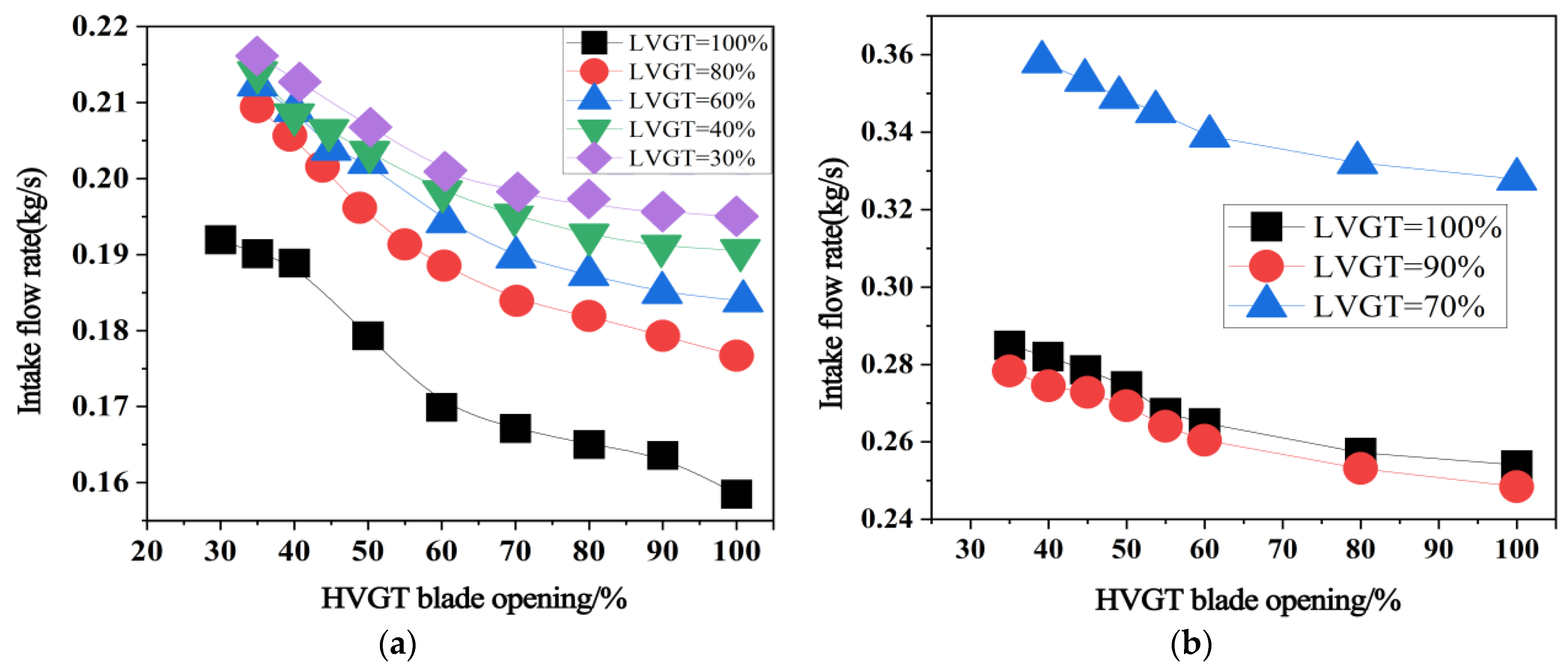
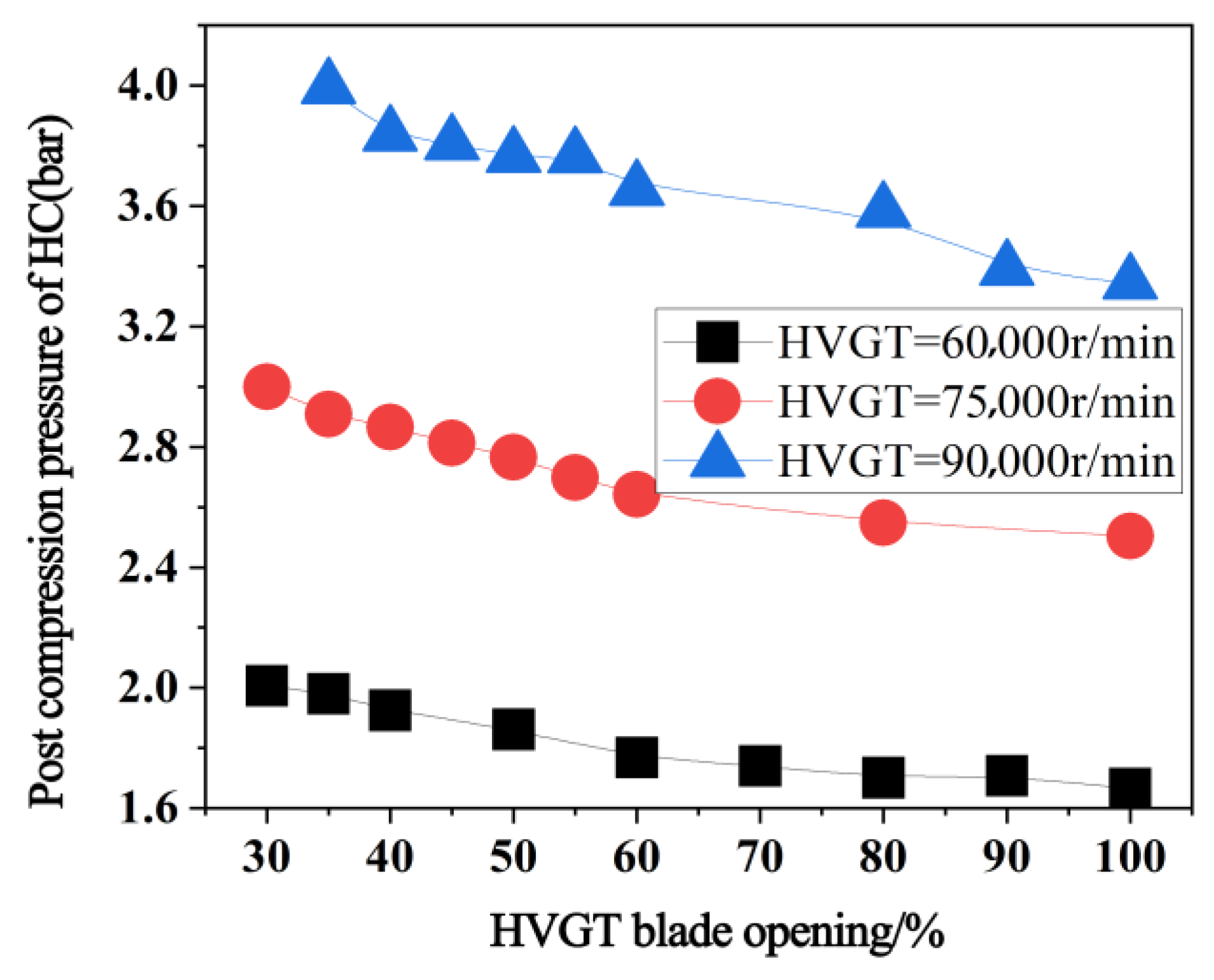


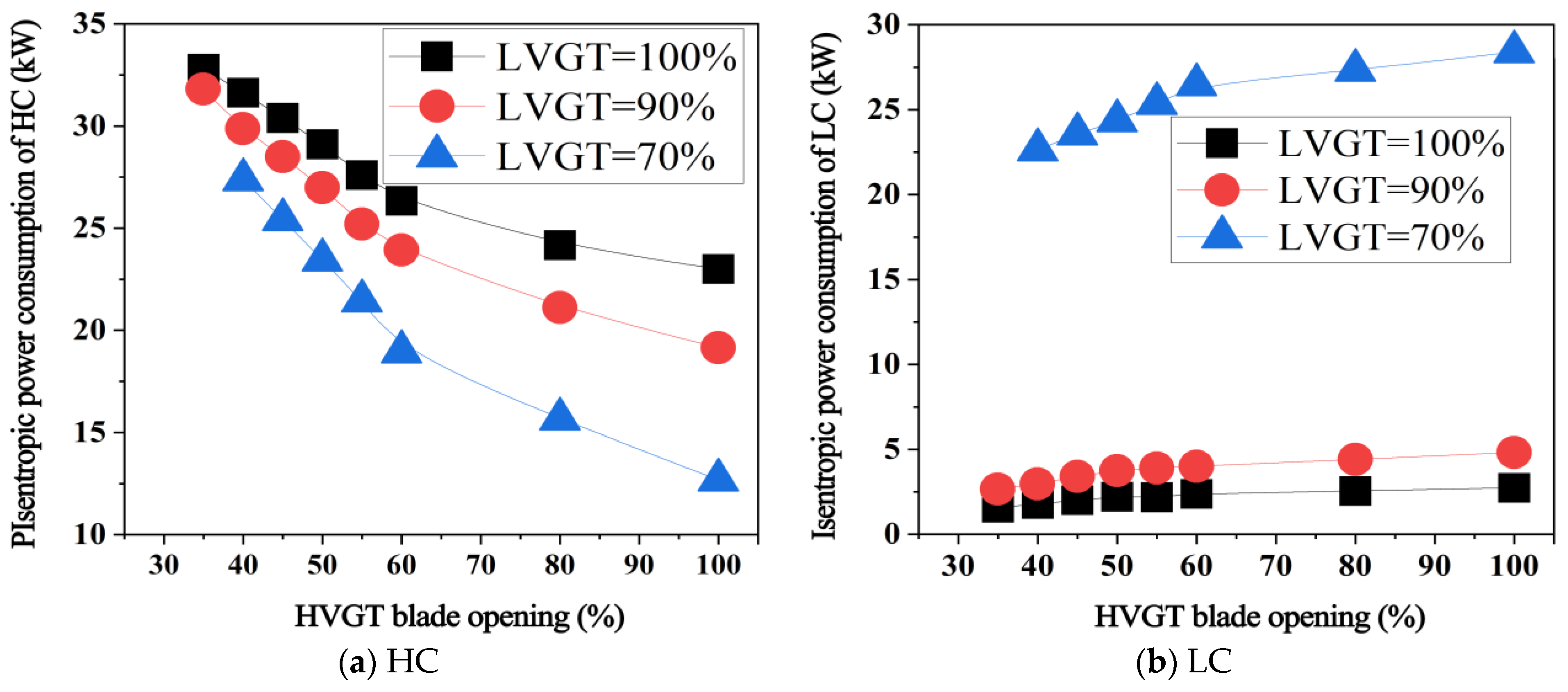
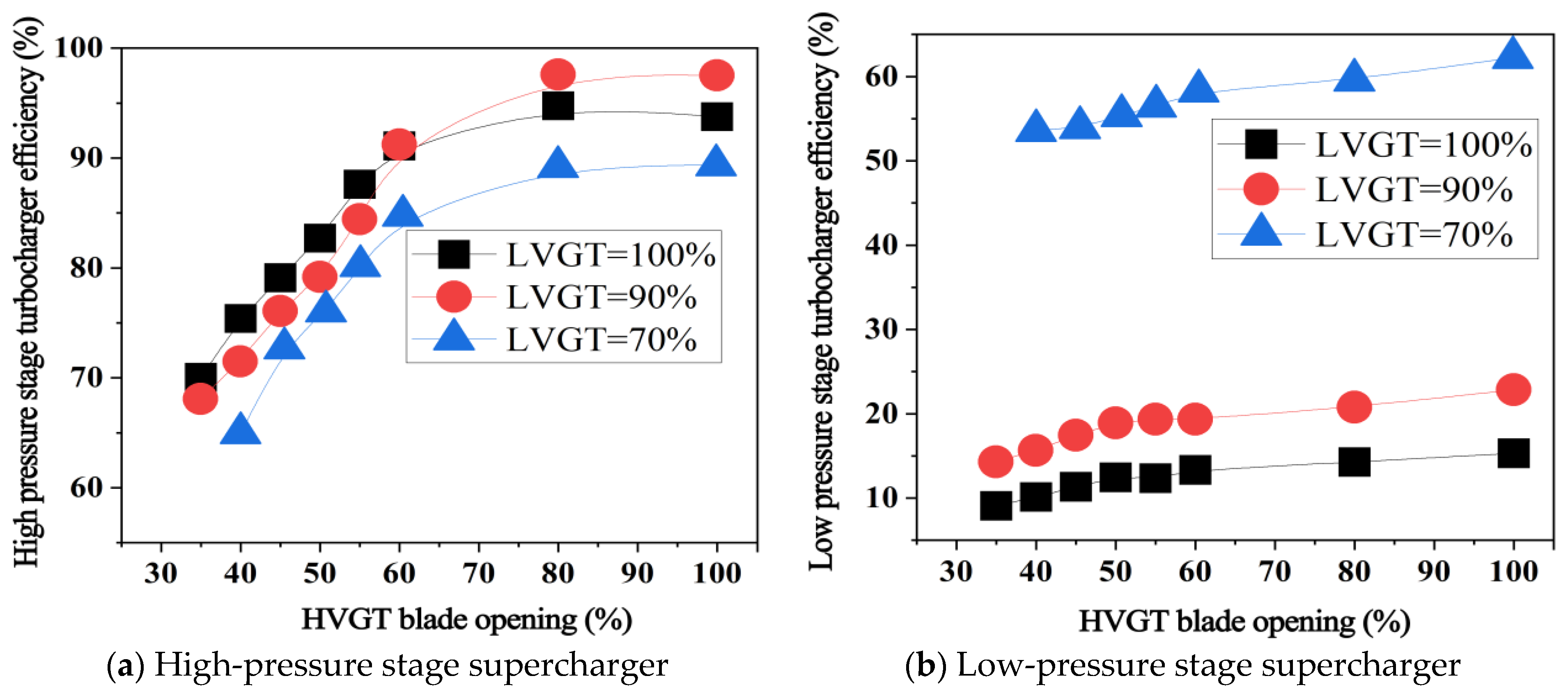
| Turbocharger | Compressor Impeller Inlet Diameter/mm | Compressor Inlet Diameter/mm | Compressor Outlet Diameter/mm | Impeller Outlet Diameter/mm | Turbine Inlet Diameter/mm | Turbine Outlet Diameter/mm | Exhaust Pipe Diameter/mm |
|---|---|---|---|---|---|---|---|
| KD76GCT | 52 | 52.8 | 62 | 76 | 74.5 | 60 | 61 |
| KD100GCT | 67 | 68 | 82.2 | 100 | 82 | 75 | 76 |
| Name (Quantity) | Model Number | Main Measurement Parameters | Measurement Accuracy |
|---|---|---|---|
| Pressure sensor (8) | Piezoresistive pressure sensor | Inlet and outlet air pressure of compressor and turbine | ±0.5% |
| Pressure transmitter (2) | Electric transmitter | Compressor outlet pressure, turbine inlet pressure | ±0.08% FS |
| Temperature sensor (4) | Platinum thermal resistance sensor | Inlet and outlet air temperature of compressor and turbine | ±0.5 °C |
| Temperature transmitter (2) | Thermal resistance isolated transmitter | Compressor outlet air temperature, turbine inlet air temperature | ±0.2%FS |
| Flow sensor (2) | Twisted-wire flowmeter | Compressor outlet flow, turbine inlet flow | >1% |
| Tachometer sensor (1) | Non-contact magnetoelectric | Turbocharger speed | ≥±0.2% |
| Test Conditions | HVGT Vane Adjustment Opening (%) | LVGT Vane Adjustment Opening (%) | Initial Speed of High-Pressure Stage (r/min) | Low-Pressure Stage RPM(r/min) |
|---|---|---|---|---|
| A | 100% | 30%, 60%, 80%, 100% | 60,000, 75,000, 95,000 | Adjust the burner pressure, temperature and flow rate to increase the low-pressure stage speed, so that the low-pressure stage speed is stable to 50,000~100,000. |
| B | 100% | 30%, 60%, 80%, 100% | 60,000, 75,000, 95,000 | |
| C | 100% | 30%, 60%, 80%, 100% | 60,000, 75,000, 95,000 | |
| D | 100% | 30%, 60%, 80%, 100% | 60,000, 75,000, 95,000 | |
| E | 100% | 30%, 60%, 80%, 100% | 60,000, 75,000, 95,000 | |
| F | 100% | 30%, 60%, 80%, 100% | 60,000, 75,000, 95,000 | |
| A1 | 80% | 30%, 60%, 80%, 100% | 60,000, 75,000, 95,000 | |
| B1 | 80% | 30%, 60%, 80%, 100% | 60,000, 75,000, 95,000 | |
| C1 | 80% | 30%, 60%, 80%, 100% | 60,000, 75,000, 95,000 | |
| D1 | 80% | 30%, 60%, 80%, 100% | 60,000, 75,000, 95,000 | |
| E1 | 80% | 30%, 60%, 80%, 100% | 60,000, 75,000, 95,000 | |
| F1 | 80% | 30%, 60%, 80%, 100% | 60,000, 75,000, 95,000 | |
| A2 | 60% | 30%, 60%, 80%, 100% | 60,000, 75,000, 95,000 | |
| B2 | 60% | 30%, 60%, 80%, 100% | 60,000, 75,000, 95,000 | |
| C2 | 60% | 30%, 60%, 80%, 100% | 60,000, 75,000, 95,000 | |
| D2 | 60% | 30%, 60%, 80%, 100% | 60,000, 75,000, 95,000 | |
| E2 | 60% | 30%, 60%, 80%, 100% | 60,000, 75,000, 95,000 | |
| F2 | 60% | 30%, 60%, 80%, 100% | 60,000, 75,000, 95,000 | |
| A3 | 30% | 30%, 60%, 80%, 100% | 60,000, 75,000, 95,000 | |
| B3 | 30% | 30%, 60%, 80%, 100% | 60,000, 75,000, 95,000 | |
| C3 | 30% | 30%, 60%, 80%, 100% | 60,000, 75,000, 95,000 | |
| D3 | 30% | 30%, 60%, 80%, 100% | 60,000, 75,000, 95,000 | |
| E3 | 30% | 30%, 60%, 80%, 100% | 60,000, 75,000, 95,000 | |
| F3 | 30% | 30%, 60%, 80%, 100% | 60,000, 75,000, 95,000 |
| Parameter | Blade Stroke Range (mm) | Sector Gear Angle Range (°) | Blade Displacement Per Unit Sector Gear Angle (mm/°) | Blade Displacement Per Unit Motor Angle (mm/°) | |
|---|---|---|---|---|---|
| Blade Stroke | |||||
| Effective working stroke of nozzle moving blade | 0~15 | 0~18.4 | 0.813 | 0.00769 | |
| Theoretical maximum stroke of nozzle moving blade | 0~16.5 | 0~20.3 | |||
Disclaimer/Publisher’s Note: The statements, opinions and data contained in all publications are solely those of the individual author(s) and contributor(s) and not of MDPI and/or the editor(s). MDPI and/or the editor(s) disclaim responsibility for any injury to people or property resulting from any ideas, methods, instructions or products referred to in the content. |
© 2023 by the authors. Licensee MDPI, Basel, Switzerland. This article is an open access article distributed under the terms and conditions of the Creative Commons Attribution (CC BY) license (https://creativecommons.org/licenses/by/4.0/).
Share and Cite
Peng, Q.; Zhang, Z.; Zhou, G.; Dong, S.; Zhao, X.; Zhang, H.; Liu, R.; Cai, J. Experimental Study on the Flow Characteristics of Two-Stage Variable Turbines in a Twin-VGT System. Energies 2023, 16, 7873. https://doi.org/10.3390/en16237873
Peng Q, Zhang Z, Zhou G, Dong S, Zhao X, Zhang H, Liu R, Cai J. Experimental Study on the Flow Characteristics of Two-Stage Variable Turbines in a Twin-VGT System. Energies. 2023; 16(23):7873. https://doi.org/10.3390/en16237873
Chicago/Turabian StylePeng, Qikai, Zhongjie Zhang, Guangmeng Zhou, Surong Dong, Xumin Zhao, Han Zhang, Ruilin Liu, and Jun Cai. 2023. "Experimental Study on the Flow Characteristics of Two-Stage Variable Turbines in a Twin-VGT System" Energies 16, no. 23: 7873. https://doi.org/10.3390/en16237873
APA StylePeng, Q., Zhang, Z., Zhou, G., Dong, S., Zhao, X., Zhang, H., Liu, R., & Cai, J. (2023). Experimental Study on the Flow Characteristics of Two-Stage Variable Turbines in a Twin-VGT System. Energies, 16(23), 7873. https://doi.org/10.3390/en16237873






